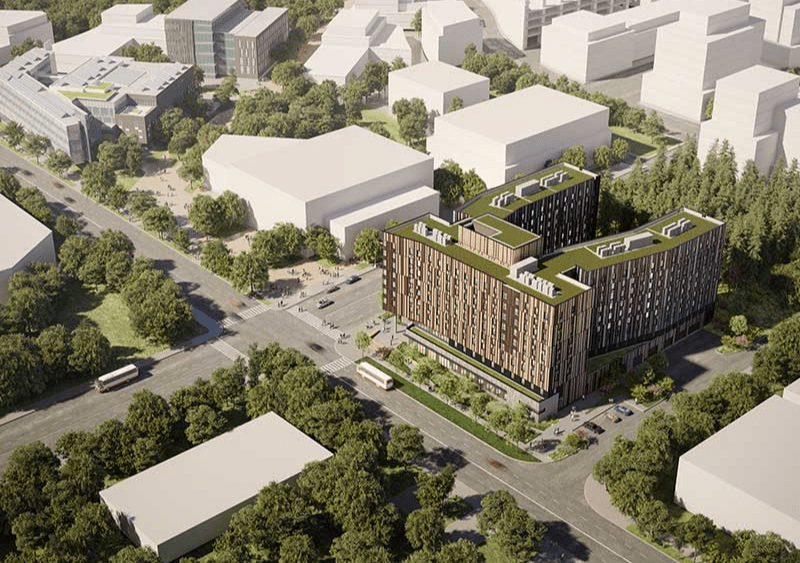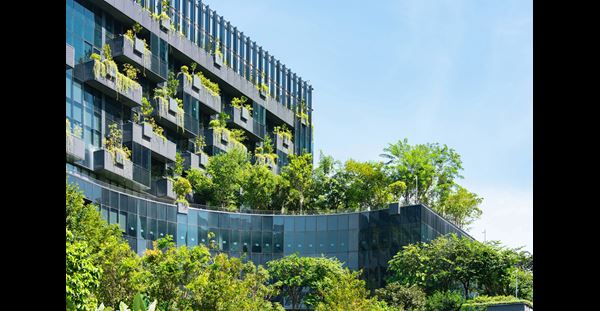Architect and Certified Passive House Consultant, Padraig McMorrow, and Cardiff Studio Director, Andrew Street take a look at the global challenges facing built environment professionals, as well as the sustainable solutions and goals that can help us create a healthier present and future.
What does sustainability mean in terms of architecture?
The United Nations Sustainable Development Goals describe sustainable development as one that meets the needs of the present without compromising the ability of future generations to meet their own needs.
Measurable goals and sustainable outcomes
As architects and designers, we focus our efforts in creating a sustainable future by developing an approach built on three core areas:



The healthy future of the earth’s climate and ecology are central to this philosophy; our climate sustainability goals are combined with social and economic wellbeing goals to ensure sustainable development can be achieved and adapted widely.
As designers, we align our sustainable development goals with the Royal Institute of British Architects (RIBA) Sustainable Outcomes. These outcomes are:








As practitioners of sustainable building and development, we must demonstrate that our projects will have a positive impact on these eight pillars of sustainability.
Environment

The role of buildings in reducing the global climate change impact is significant, as they account for 39 per cent of energy-related global CO2 emissions (2018 Global Status Report, Global Alliance for Buildings and Construction & International Energy Agency).
There are two main pillars on which we measure a building’s impact on the environment—operational energy and whole life carbon.
Operational energy
Operational energy is also measured in the Passive House standard for low energy use in buildings; this is a globally-recognized, stringent standard that we are currently certifying multiple projects to. Innovating globally, these “envelope first” strategies for reducing operational energy are hardwired into our design approach. These include:



In addition to the high-performance building envelope, we utilize powerful technologies and building techniques to create healthy, comfortable, and efficient buildings.
-
READ MORE
Technologies and methods, such as highly efficient mechanical and electrical systems, heat recovery, and optimized glazing, enable us to avoid the use of fossil fuels, exploit renewable energy where possible, and reduce wasted energy.
Whole life carbon assessment

The global conversation around environmental sustainability has now moved to a holistic approach to a building’s life cycle carbon modelling. Whole life carbon assessment (WLCA) measures all stages of carbon related to buildings, allowing a true net zero lifecycle to be achieved for buildings.
-
READ MORE
The UK and international construction industry is currently at a crossroads where the framework for WLCA is being defined and benchmarked, with emerging standards and targets outlined, and best practice implemented in line with RICS WLCA guidance.
We are developing solutions which integrate our BIM processes to the carbon counting process; we are uniquely placed as an integrated design and technology firm to be at the leading-edge of the anticipated widespread adoption of WLCA in global building practice.
Societal and economic sustainability

As architects and designers, we can influence and inform, but sustainable development will always be a team effort. To achieve these sustainability goals, education, policy and government funding are key.
-
READ MORE
As seen in our Swansea Bay Technology Centre project, both the government and client were aligned in putting sustainability at the forefront of the design, and the outcome is an exciting step on the path to net zero buildings and to net positive.
Excess energy generated by the building will be sold back to the grid, an example of circular economy in practice. Tight renewable energy loops and sustainable solutions help to reduce carbon emissions in our communities with great economic benefits.
The building is designed to produce renewable electricity throughout its life, thereby offsetting the carbon emitted earlier in its life. Every effort has been made to reduce the embodied carbon, but the renewable offsetting is what allows the building to be truly net zero in its lifecycle.
Future widespread sustainable and net zero development is achievable.

Leveraging our technology capabilities, we are empowered to select the most efficient solutions. There is endless potential for innovation, new products and building techniques going forward to assist us in designing, planning and creating a sustainable future for our built environment.
-
READ MORE
We are already achieving these sustainable outcomes in our exemplar projects. The global challenge facing built environment professionals is to continue to apply sustainable goals to all development activity; only then can we turn the tide and globally make a net positive contribution to the wellbeing of future generations.
Arcadis’ design strategies for sustainable outcomes

















